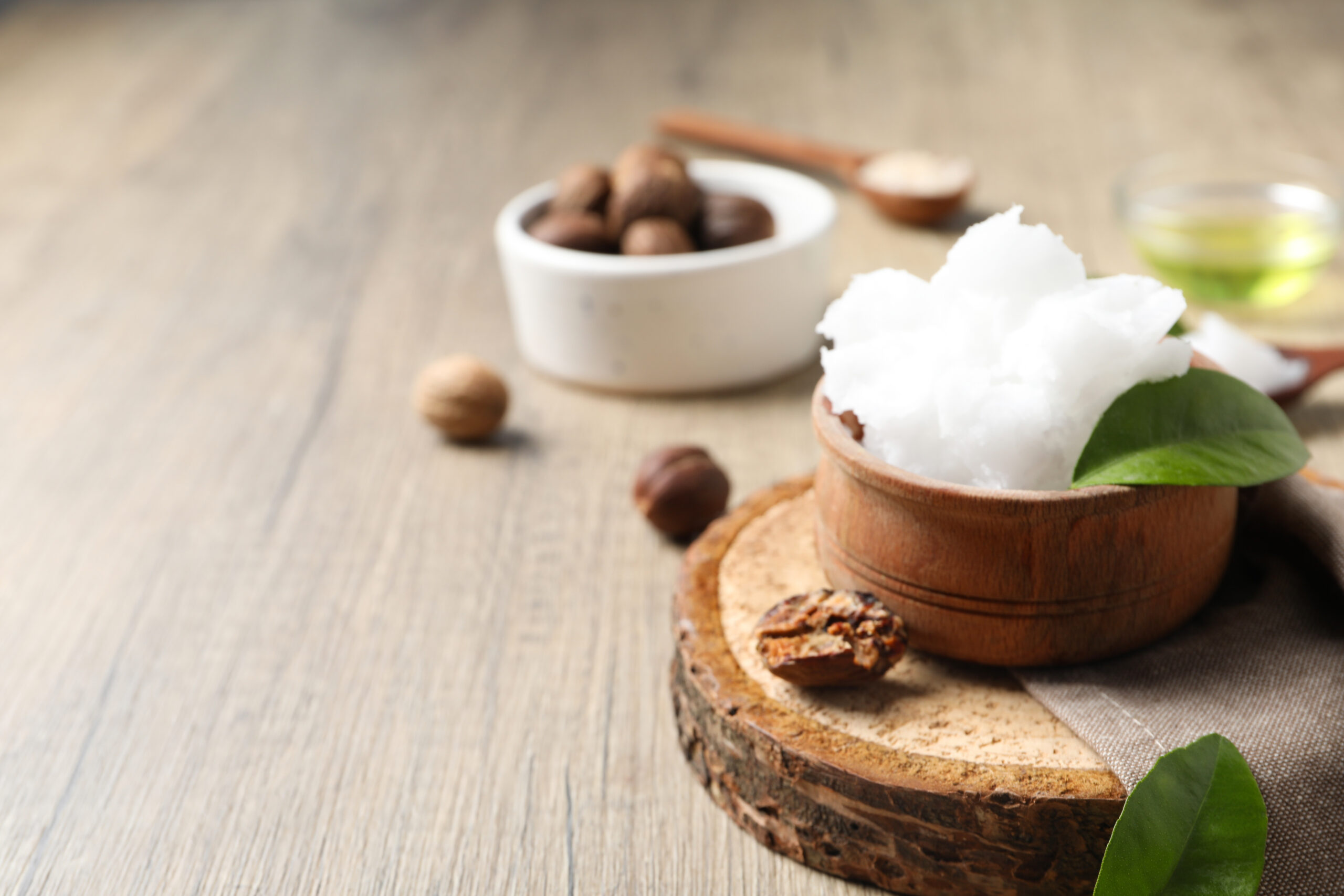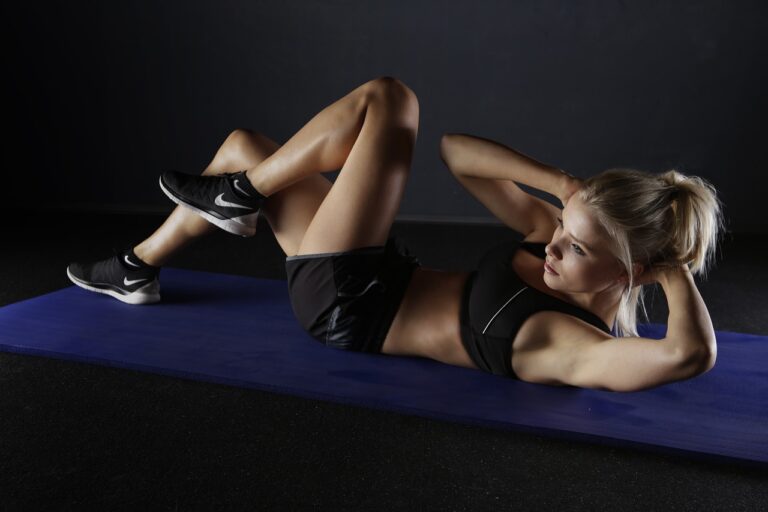Shea Butter: Your Ultimate Guide to Luxurious, Natural DIY Skincare (Over 15 Easy Recipes!)
Hook: Imagine a single, natural ingredient capable of transforming dry, cracked skin into velvety softness, calming irritated complexions, shielding against environmental damage, and even smoothing stubborn scars. Not a fantasy potion, but the humble, powerhouse Shea Butter – nature’s gift to radiant, healthy skin. Forget expensive, chemical-laden creams; unlock the secrets of pure, unadulterated skincare magic right in your kitchen. This isn’t just a trend; it’s a return to potent, earth-derived beauty that truly works.
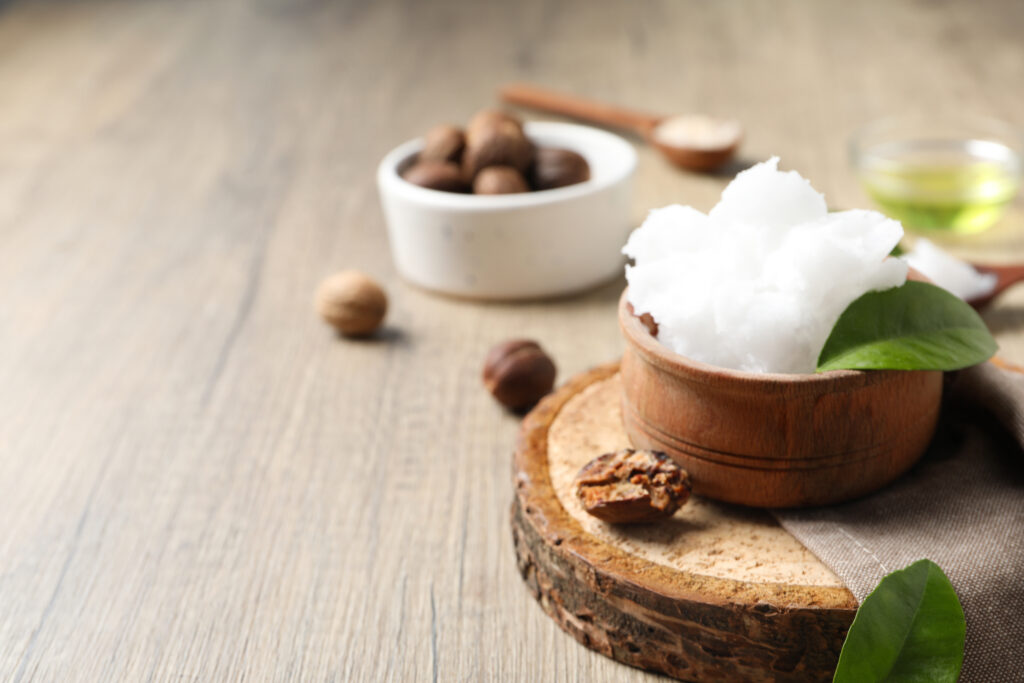
Introduction: Why Shea Butter Deserves a Prime Spot in Your Beauty Ritual
In a world overflowing with complex skincare routines and synthetic ingredients, the allure of pure, effective, natural solutions is stronger than ever. Enter Shea Butter, a golden treasure hailing from the heart of Africa. Revered for centuries for its remarkable healing and moisturizing properties, this solid fat, extracted from the nuts of the Vitellaria paradoxa (or Butyrospermum parkii) tree, is more than just a moisturizer—it’s a multi-tasking skincare superhero.
As a Healthy Beauty advocate , I’ve seen firsthand the transformative power of integrating high-quality, natural ingredients like shea butter into daily routines. Not only does it deliver visible results—intense hydration, improved elasticity, a calmer complexion—but it also aligns with a conscious, sustainable approach to beauty. This comprehensive guide dives deep into the science, the sourcing, and, most excitingly, provides you with over 15 easy, effective DIY skincare recipes harnessing the magic of Shea Butter. Get ready to whip up luxurious creams, healing balms, and rejuvenating treatments that rival high-end brands, all while knowing exactly what you’re putting on your skin.
Understanding the Gold: What Exactly is Shea Butter?
Shea Butter isn’t just a butter; it’s a complex blend of beneficial compounds:
- Source: Derived from the nuts of the Shea tree, native to the dry savannah regions of West and Central Africa.
- Extraction: Traditionally, it’s a labor-intensive process involving harvesting, cracking, roasting, grinding, kneading, and separating the oils to yield the precious butter. This unrefined, raw butter is the gold standard for skincare.
- Composition: Its magic lies in its unique composition:
- Triglycerides (Oils): Provide deep emollience and occlusion (sealing in moisture).
- Unsaponifiables (4-11% – a very high amount!): This is where the true therapeutic power resides. Includes:
- Vitamins A & E: Potent antioxidants that fight free radicals, support skin repair, and promote collagen production.
- Cinnamic Acid Esters: Offer natural sun protection (though not a replacement for sunscreen) and have anti-inflammatory properties.
- Phytosterols (Like Beta-Sitosterol): Mimic skin lipids, deeply nourish, reduce inflammation, and accelerate healing.
- Triterpenes: Contribute to anti-inflammatory and anti-microbial effects.
- Fatty Acids:
- Oleic Acid (40-60%): A monounsaturated omega-9 fatty acid that penetrates deeply, providing lasting moisture and improving skin suppleness.
- Stearic Acid (20-50%): A saturated fatty acid that gives shea its solid texture at room temperature, creates a protective barrier, and has cleansing properties.
- Linoleic Acid (3-11%): An essential omega-6 fatty acid crucial for maintaining the skin barrier, reducing inflammation, and preventing moisture loss. Vital for acne-prone skin.
- Palmitic Acid (2-9%): Another saturated fatty acid contributing to barrier function and texture.
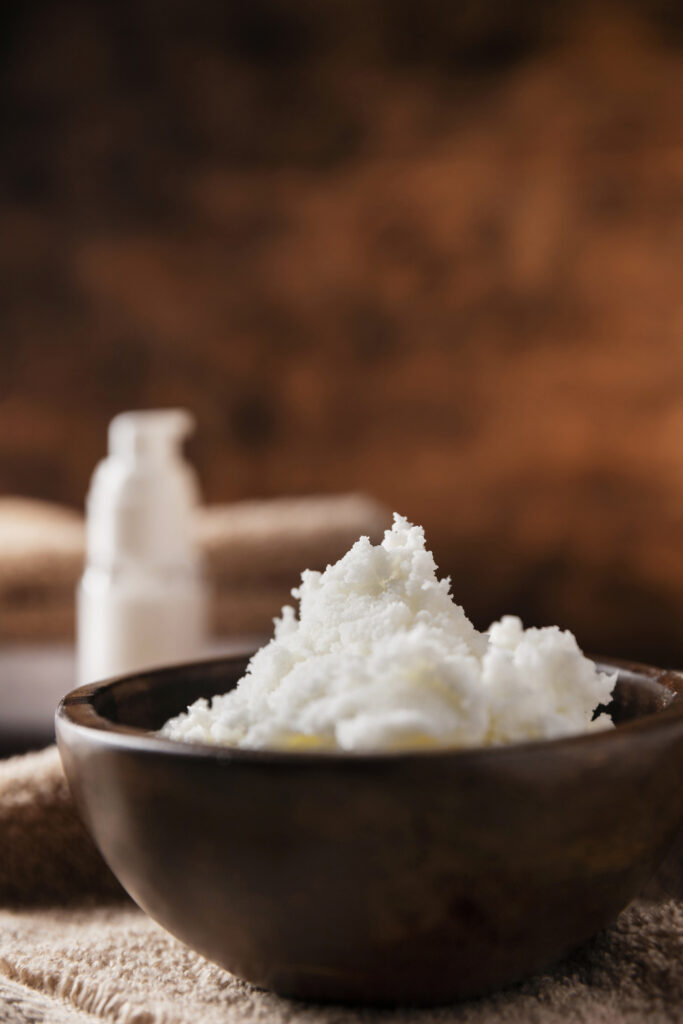
Raw vs. Refined vs. Ultra-Refined: Choosing Your Shea Butter Wisely
- Raw / Unrefined Shea Butter:
- Process: Minimal processing, typically filtered mechanically without chemicals or high heat. Often handcrafted.
- Color: Ivory to deep yellow or greyish-beige (natural color varies).
- Scent: Distinctive, nutty, earthy aroma (some find it strong, others love it).
- Texture: Rich, creamy, sometimes slightly grainy (which melts beautifully on skin contact).
- Benefits: Contains the highest concentration of vitamins, antioxidants, and unsaponifiables. Offers maximum therapeutic benefits. This is the BEST choice for DIY skincare and our recipes.
- Refined Shea Butter:
- Process: Filtered, bleached (often with clay), and deodorized using steam or chemicals. Higher heat may be used.
- Color: Consistent, pure white.
- Scent: Very mild to odorless.
- Texture: Smooth, uniform, less creamy than raw.
- Benefits: Removes the natural scent and color. Some beneficial compounds are lost during processing. Primarily acts as an occlusive moisturizer and emollient. Lacks the full therapeutic punch of raw shea.
- Ultra-Refined Shea Butter:
- Process: Highly processed using solvents and high heat to remove all color, scent, and impurities.
- Color: Pure white.
- Scent: Odorless.
- Texture: Very hard, waxy, not creamy.
- Benefits: Primarily used as a base ingredient in cosmetics for its texture and stability. Most beneficial compounds are destroyed. Not recommended for therapeutic DIY skincare.
Why Raw Unrefined Shea Butter Reigns Supreme for DIY:
For the potent skin-loving benefits we crave – deep healing, intense nourishment, antioxidant protection, and anti-aging effects – Raw, Unrefined Shea Butter is unequivocally the champion. Its natural state preserves the delicate vitamins, phytosterols, and other unsaponifiables that make it so extraordinary. Embrace the natural color and scent; it’s the hallmark of purity and potency!
The Science-Backed Benefits of Shea Butter for Skin (And Hair!)
Shea Butter isn’t just folk wisdom; its efficacy is increasingly supported by scientific research:
- Intense Moisturization & Barrier Repair:
- How: Its high concentration of fatty acids (oleic, stearic, palmitic) acts as exceptional emollients, filling in cracks between skin cells, and occlusives, forming a protective seal to prevent Trans-Epidermal Water Loss (TEWL). Phytosterols mimic skin lipids, reinforcing the barrier.
- Benefits: Dramatically improves skin hydration, softens rough patches (elbows, knees, heels), soothes extreme dryness (eczema, psoriasis patches), and creates a lasting protective layer. Ideal for body butters and hand creams.
- Powerful Anti-Inflammatory & Soothing:
- How: Cinnamic acid esters, lupeol cinnamate, and phytosterols (like beta-sitosterol) possess significant anti-inflammatory properties. Triterpenes also contribute.
- Benefits: Calms redness, irritation, itching associated with eczema, psoriasis, dermatitis, insect bites, sunburn, and razor burn. Reduces skin reactivity. Perfect for after-sun care and soothing balms.
- Rich in Antioxidants (Vitamins A & E):
- How: Vitamin A (in the form of carotenoids) promotes cell turnover and repair. Vitamin E (tocopherols) is a potent free radical scavenger.
- Benefits: Fights oxidative stress caused by UV rays, pollution, and other environmental aggressors. Helps prevent premature aging (fine lines, wrinkles), brightens skin tone, and supports overall skin health. Key for anti-aging serums and facial creams.
- Collagen Boosting & Anti-Aging:
- How: Vitamin A stimulates fibroblast activity, encouraging collagen and elastin production. The moisturizing and antioxidant effects work synergistically.
- Benefits: Improves skin elasticity and firmness, plumps the skin, reduces the appearance of fine lines and wrinkles, and promotes a more youthful complexion.
- Enhanced Wound Healing & Scar Reduction:
- How: Anti-inflammatory properties reduce swelling and redness. Emollient properties keep the wound area supple, preventing cracking. Compounds like allantoin (sometimes naturally present or added) and phytosterols specifically promote cell regeneration and tissue repair.
- Benefits: Accelerates the healing of minor cuts, scrapes, burns, and surgical scars. Helps fade the appearance of old scars, stretch marks, and hyperpigmentation over time. The basis for healing salves and scar treatments.
- Mild Natural Sun Protection:
- How: Cinnamic acid esters absorb UV radiation, particularly in the UV-B range.
- Benefits: Offers an estimated SPF of 3-6. Crucially, this is NOT sufficient protection on its own. However, it provides supplementary protection and antioxidant support when used under a broad-spectrum mineral sunscreen. Excellent in after-sun recovery lotions.
- Hair & Scalp Nourishment:
- How: Moisturizes dry scalp, conditions hair shafts, reduces frizz, adds shine, and provides some heat protection.
- Benefits: Treats dry, flaky scalp; tames frizz; defines curls; protects hair from environmental damage and styling stress. Used in hair masks, leave-in conditioners, and styling creams.
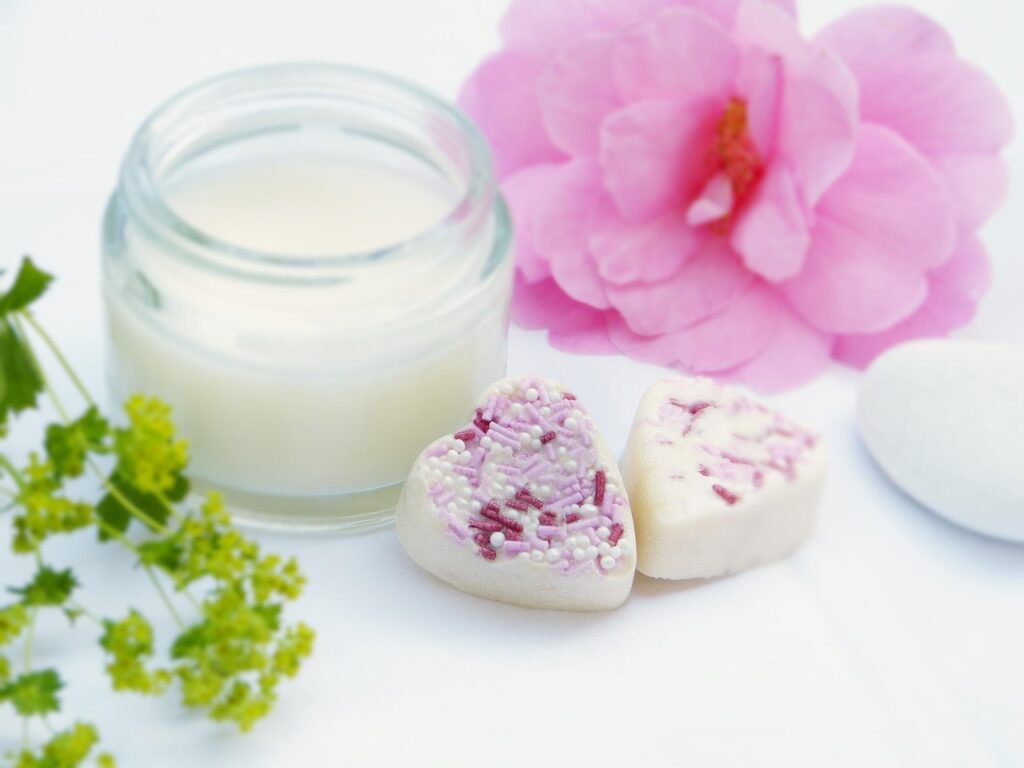
Ethical Sourcing: Beauty with a Conscience
Choosing Shea Butter isn’t just good for your skin; it can be incredibly impactful for communities. The shea industry is predominantly female-driven in West Africa:
- Women’s Cooperatives: Look for brands sourcing directly from women’s cooperatives (e.g., in Ghana, Burkina Faso, Togo, Benin). This ensures fair wages, safe working conditions, and empowers women economically.
- Fair Trade Certification: Certifications like Fair Trade USA or WFTO guarantee fair prices and social premiums for community development.
- Sustainable Harvesting: Responsible harvesting protects the shea parklands, crucial ecosystems.
- Transparency: Support brands transparent about their supply chain.
- Organic: While not always certified due to the wild nature of many trees, organic shea butter ensures no harmful pesticides or chemicals were used in processing.
Preparing for Your DIY Adventure: Essential Tools & Ingredients
Creating your own Shea Butter skincare is simple, but having the right setup makes it smoother and more hygienic:
- Essential Tools:
- Double Boiler or Heat-Safe Bowl over Pot: Gentle, even melting is key. Never melt shea butter directly in a pot over high heat!
- Digital Kitchen Scale: Accuracy is crucial, especially for emulsified products (lotions/creams).
- Glass Measuring Cups & Spoons: For oils and butters (heat-safe) and powders/EOs.
- Stainless Steel Whisk & Spatulas: Silicone spatulas are great for scraping.
- Hand Mixer or Immersion (Stick) Blender: Essential for whipping body butters and emulsifying lotions.
- Glass Jars & Containers (Various Sizes): Dark glass (amber, cobalt) is best for light-sensitive ingredients. Ensure they are sterilized (boiled or washed in very hot soapy water, rinsed well, and dried completely).
- Labels & Marker: Crucial for identifying your creations and noting the date.
- Thermometer (Optional but Helpful): Useful for emulsified recipes to monitor oil and water phase temperatures.
- Core Ingredients Beyond Shea Butter:
- Carrier Oils: Coconut Oil (fractionated is liquid), Sweet Almond Oil, Jojoba Oil, Olive Oil, Argan Oil, Grapeseed Oil, Avocado Oil, Rosehip Seed Oil, Sunflower Oil. Each offers unique benefits.
- Essential Oils (EOs): Lavender (calming), Tea Tree (acne), Frankincense (anti-aging), Peppermint (invigorating), Chamomile (soothing), Geranium (balancing), Lemon (brightening – photosensitizing, use caution). Always use 100% pure, therapeutic-grade EOs. Dilute properly (usually 1-2% max in leave-on products). Patch test!
- Beeswax (Pellets or Pastilles): Adds hardness, structure, and water resistance to balms and salves. Vegan alternative: Candelilla Wax or Carnauba Wax.
- Emulsifying Wax: Crucial for blending water and oil phases in lotions and creams. Look for natural options like BTMS-50 or Olivem 1000.
- Preservatives (Non-Negotiable for Water-Based Products): Essential to prevent mold and bacteria growth in lotions, creams, or anything containing water/aloe/water-based ingredients. Options: Leucidal Liquid (radish root ferment), Geogard ECT (blend), EcoCert-approved blends. Do NOT skip this for emulsified products!
- Butters: Cocoa Butter (hard, protective, chocolate scent), Mango Butter (firm, smooth, mild scent).
- Botanicals (Optional): Dried herbs (calendula, chamomile – for infused oils), clays (kaolin, bentonite – masks), colloidal oatmeal (soothing).
- Actives (Optional for Advanced): Vitamin E Oil (antioxidant, extends shelf life), Aloe Vera Gel (soothing, hydrating – needs preservative), Allantoin (soothing, healing).
- Safety First:
- Sterilization: Clean all tools and containers meticulously.
- Patch Testing: ALWAYS test a small amount of any new DIY product (or new ingredient like an EO) on your inner arm for 24-48 hours before widespread use.
- EO Dilution: Research safe usage rates. Less is often more. Avoid using photosensitizing EOs (like citrus) before sun exposure.
- Preservatives: Use them correctly in water-containing products. Never use water without one.
- Labeling: Include ingredients and date made.
Mastering the Art of Working with Shea Butter: Melting, Whipping, Storing
- Melting: Always use gentle, indirect heat. Place your shea butter (chopped if in a large block) in a heat-safe bowl or the top of a double boiler. Heat over simmering water, stirring occasionally, until just melted. Avoid overheating, as high temperatures can degrade its beneficial properties and cause graininess. Remove from heat immediately once melted.
- Whipping (For Fluffy Body Butters):
- Melt your shea butter and any other solid oils/butters gently.
- Let the mixture cool slightly, then place the bowl in the refrigerator or freezer. Monitor it closely.
- When it starts to solidify around the edges but is still slightly soft/slushy in the center (like thick pudding or softened butter consistency – usually 15-45 mins depending on batch size and fridge temp), remove it.
- Add liquid carrier oils and essential oils (if using).
- Whip vigorously with a hand mixer or stand mixer until light, fluffy, and pale (like whipped cream). This incorporates air, creating a luxurious texture that melts beautifully on skin. Do not whip while still fully liquid or fully solid.
- Storing Your Creations:
- Anhydrous Products (No Water): Body Butters, Balms, Salves. Store in sterilized, airtight containers (glass jars/tins) in a cool, dark place (like a cupboard). Shelf life: Typically 6 months to 1 year, depending on ingredients. Heat and light are enemies.
- Emulsified Products (Contain Water): Lotions, Creams. Must contain a preservative. Store in sterilized, airtight containers (pumps or tubes are best to minimize contamination) in a cool, dark place. Shelf life: Typically 3-6 months with preservative. Refrigeration can extend life. Discard if smell, color, or texture changes.
- Raw Shea Butter: Store in an airtight container in a cool, dark place (pantry is fine). Can last 1-2 years. If it becomes very grainy, you can gently remelt it and let it cool slowly at room temperature.
Over 15 Easy & Effective DIY Shea Butter Skincare Recipes
Section 1: Luxurious Body Care
- Ultra-Nourishing Whipped Shea Body Butter (Signature Recipe!)
- Focus Keyword: Shea Butter Body Butter
- Why: The ultimate hydration bomb for dry skin. Light, fluffy, and melts instantly.
- You’ll Need:
- 1/2 cup Raw Unrefined Shea Butter
- 1/4 cup Coconut Oil (Solid) or Mango Butter
- 1/4 cup Sweet Almond Oil (or Jojoba, Sunflower)
- 15-20 drops Essential Oils (e.g., Lavender & Vanilla, Orange & Geranium) – Optional
- 1 tsp Vitamin E Oil – Optional (Antioxidant)
- Instructions:
- Combine shea butter, coconut oil/mango butter in a double boiler. Melt gently over simmering water.
- Remove from heat. Stir in liquid carrier oil and Vitamin E (if using). Let cool 5-10 mins.
- Place bowl in fridge/freezer. Check every 10-15 mins. When edges are firming but center is still soft/slushy, remove.
- Add EOs (if using). Whip with a hand mixer on high speed for 5-10 minutes until light, fluffy, and pale. It will increase in volume significantly.
- Scoop into sterilized glass jars. Store in a cool, dark place. Use: Apply liberally to damp skin after showering. Especially great for legs, arms, elbows, knees.
- Soothing Shea & Oatmeal Body Cream (For Sensitive/Itchy Skin)
- Focus Keyword: Shea Butter for Dry Skin
- Why: Colloidal oatmeal calms inflammation and itching; shea deeply hydrates.
- You’ll Need:
- 1/4 cup Raw Unrefined Shea Butter
- 1/4 cup Coconut Oil (Solid)
- 1/4 cup Sweet Almond Oil
- 1/4 cup Aloe Vera Gel (Preserved or fresh – if fresh, use within 1 week refrigerated)
- 2 tbsp Colloidal Oatmeal (Finely ground oats – use a coffee grinder)
- 10 drops Lavender Essential Oil – Optional
- 1/2 tsp Preservative (e.g., Leucidal Liquid SF) – Essential!
- Instructions:
- Melt shea butter and coconut oil in double boiler. Remove from heat.
- Stir in sweet almond oil. Let cool slightly (around 100-110°F).
- In a separate bowl, whisk aloe vera gel and preservative. Warm gently if needed to match oil phase temp.
- Slowly drizzle the aloe mixture into the oil mixture while whisking vigorously or using a stick blender. Blend until thickened and emulsified.
- Whisk in colloidal oatmeal and lavender EO (if using).
- Pour into sterilized container (pump bottle ideal). Use: Apply to itchy, dry, or irritated areas (eczema, psoriasis patches – patch test first!). Calms and moisturizes instantly.
- Invigorating Coffee & Shea Body Scrub
- Focus Keyword: Shea Butter Scrub
- Why: Exfoliates dead skin, improves circulation, moisturizes deeply, fights cellulite appearance.
- You’ll Need:
- 1/2 cup Raw Unrefined Shea Butter (softened but not melted)
- 1/2 cup Coconut Oil (Solid)
- 1 cup Finely Ground Coffee (Used or fresh)
- 1/4 cup Brown Sugar or Sea Salt (Fine grain)
- 15 drops Grapefruit or Peppermint Essential Oil – Optional
- Instructions:
- In a bowl, combine softened shea butter and coconut oil. Mash/mix well.
- Add ground coffee and sugar/salt. Mix thoroughly.
- Stir in essential oils (if using).
- Scoop into sterilized jar. Use: In the shower, massage onto damp skin (avoiding face) in circular motions. Rinse thoroughly. Leaves skin incredibly smooth and hydrated. Use 1-2 times per week. Caution: Can make shower slippery!
Section 2: Targeted Treatments (Hands, Feet, Lips)
- Healing Shea Butter Hand Salve (For Cracked Hands)
- Focus Keyword: Shea Butter for Hands
- Why: Intensive repair for dry, cracked, overworked hands. Creates a protective barrier.
- You’ll Need:
- 1/4 cup Raw Unrefined Shea Butter
- 2 tbsp Beeswax Pellets (or Candelilla Wax for vegan)
- 2 tbsp Sweet Almond Oil
- 1 tbsp Jojoba Oil
- 10 drops Frankincense Essential Oil (Healing) – Optional
- 5 drops Lavender Essential Oil (Calming) – Optional
- Instructions:
- Combine shea butter, beeswax, and carrier oils in a double boiler. Melt gently.
- Remove from heat. Stir in essential oils (if using).
- Carefully pour into small sterilized tins or lip balm tubes. Let cool completely until solid. Use: Apply liberally to clean hands, especially before bed and after washing. Wear cotton gloves overnight for intense repair.
- Ultra-Hydrating Shea Butter Foot Cream
- Focus Keyword: Shea Butter Foot Cream
- Why: Tackles rough heels and dry soles with intense moisture and softening.
- You’ll Need:
- 1/4 cup Raw Unrefined Shea Butter
- 2 tbsp Coconut Oil
- 2 tbsp Olive Oil or Avocado Oil
- 1 tbsp Beeswax Pellets (Optional for extra barrier)
- 10 drops Peppermint Essential Oil (Cooling) – Optional
- 5 drops Tea Tree Essential Oil (Antifungal) – Optional
- Instructions:
- Melt shea butter, coconut oil, and beeswax (if using) in double boiler.
- Remove from heat. Stir in olive/avocado oil and essential oils (if using).
- Pour into sterilized jar. Let cool. Use: Massage generously into clean feet, focusing on heels and balls. Wear socks overnight for deep penetration.
- Luscious Shea & Honey Lip Balm
- Focus Keyword: Shea Butter Lip Balm
- Why: Soothes chapped lips, provides long-lasting moisture without stickiness.
- You’ll Need:
- 1 tbsp Raw Unrefined Shea Butter
- 1 tbsp Beeswax Pellets (or Candelilla Wax)
- 1 tbsp Coconut Oil
- 1 tsp Honey
- 1 tsp Sweet Almond Oil or Jojoba Oil
- 5 drops Peppermint or Vanilla Essential Oil (Food-grade) – Optional
- Instructions:
- Melt shea butter, beeswax, and coconut oil in double boiler.
- Remove from heat. Stir in sweet almond/jojoba oil and honey (stir vigorously as honey might resist).
- Add essential oil (if using). Stir well.
- Quickly pour into sterilized lip balm tubes or small tins before it sets. Use: Apply as needed throughout the day. Honey adds extra healing and subtle sweetness.
Section 3: Facial Care (Gentle & Nourishing)
- Simple Soothing Shea Facial Moisturizer (Dry/Sensitive Skin)
- Focus Keyword: Shea Butter for Face
- Why: Lightweight yet deeply nourishing for dry or sensitive faces. Non-comedogenic when used correctly.
- You’ll Need:
- 2 tbsp Raw Unrefined Shea Butter
- 1 tbsp Jojoba Oil (Mimics skin sebum)
- 1 tbsp Rosehip Seed Oil (Regenerative, anti-aging)
- 5 drops Chamomile Essential Oil (Roman or German) – Optional (Calming)
- Instructions:
- Gently melt shea butter in double boiler. Remove from heat.
- Stir in jojoba oil and rosehip seed oil.
- Let cool slightly, then whip briefly with a fork or small whisk until creamy (not fluffy like body butter).
- Stir in chamomile EO (if using).
- Store in small sterilized jar. Use: Apply a small amount (pea-sized) to damp, clean face morning and/or night. Warm between fingers first. Ideal for dry patches or as a night cream.
- Gentle Shea & Clay Cleansing Balm
- Focus Keyword: Shea Butter Cleanser
- Why: Melts makeup and sunscreen, cleanses gently without stripping, kaolin clay purifies.
- You’ll Need:
- 1/4 cup Raw Unrefined Shea Butter
- 2 tbsp Sweet Almond Oil or Sunflower Oil
- 1 tbsp Beeswax Pellets (Optional for firmness)
- 1 tbsp Kaolin Clay
- 5 drops Lavender Essential Oil – Optional
- Instructions:
- Melt shea butter and beeswax (if using) in double boiler.
- Remove from heat. Stir in carrier oil.
- Whisk in kaolin clay until smooth and no lumps remain.
- Stir in lavender EO (if using).
- Pour into small sterilized jar. Use: Scoop a small amount, massage onto dry face to melt makeup. Wet hands and continue massaging to emulsify. Rinse thoroughly with warm water and a soft cloth. Follow with toner if desired.
- Calming Shea & Aloe After-Sun Gel-Cream
- Focus Keyword: Shea Butter After Sun
- Why: Aloe cools and hydrates, shea soothes inflammation and repairs sun damage.
- You’ll Need:
- 2 tbsp Aloe Vera Gel (Preserved – Essential!)
- 1 tbsp Raw Unrefined Shea Butter (Melted)
- 1 tsp Jojoba Oil
- 5 drops Lavender Essential Oil
- 1/4 tsp Preservative (e.g., Leucidal Liquid SF) – Essential!
- Instructions:
- Gently melt shea butter in double boiler. Remove from heat, stir in jojoba oil. Let cool slightly (below 120°F).
- In a separate bowl, whisk aloe vera gel and preservative.
- Slowly drizzle the warm oil mixture into the aloe gel while whisking vigorously until combined and slightly creamy. It won’t be super thick.
- Stir in lavender EO.
- Store in sterilized jar in the refrigerator. Use: Apply generously to sun-exposed, reddened skin for instant cooling and soothing relief. Reapply as needed.
Section 4: Specialized Solutions (Scars, Stretch Marks, Babies)
- Restorative Shea & Rosehip Scar & Stretch Mark Balm
- Focus Keyword: Shea Butter for Scars
- Why: Rosehip oil (rich in trans-retinoic acid) and shea promote cell turnover and elasticity.
- You’ll Need:
- 1/4 cup Raw Unrefined Shea Butter
- 2 tbsp Rosehip Seed Oil
- 1 tbsp Coconut Oil
- 1 tbsp Beeswax Pellets (Optional)
- 10 drops Frankincense Essential Oil – Optional (Healing)
- 5 drops Helichrysum Essential Oil – Optional (Scar fading – expensive but potent)
- Instructions:
- Melt shea butter, coconut oil, and beeswax (if using) in double boiler.
- Remove from heat. Stir in rosehip seed oil.
- Stir in essential oils (if using).
- Pour into sterilized jar. Use: Gently massage into new or old scars/stretch marks 1-2 times daily. Consistency is key over weeks/months. Best on newer marks.
- Super Gentle Baby Shea Butter Balm (Diaper Area or Dry Spots)
- Focus Keyword: Shea Butter for Baby
- Why: Ultra-pure, gentle, protective. Perfect for sensitive baby skin. Avoid EOs for babies under 3 months.
- You’ll Need:
- 1/4 cup Raw Unrefined Shea Butter
- 2 tbsp Sunflower Oil or Jojoba Oil (Very gentle)
- 1 tsp Zinc Oxide Powder (Optional for diaper rash barrier) – Ensure non-nano
- Instructions:
- Melt shea butter gently in double boiler.
- Remove from heat. Stir in carrier oil.
- If using Zinc Oxide: Sift zinc oxide powder into the mixture slowly while whisking constantly to avoid lumps. Whisk thoroughly.
- Pour into sterilized jar. Use: Apply a thin layer to clean, dry baby skin. For diaper rash, apply with every change as a protective barrier. Patch test first on a small area.
Section 5: Hair & Scalp Health
- Shea Butter Hair Mask for Dry/Damaged Hair & Curls
- Focus Keyword: Shea Butter for Hair
- Why: Deeply conditions, reduces frizz, defines curls, adds shine.
- You’ll Need:
- 2 tbsp Raw Unrefined Shea Butter (Melted)
- 2 tbsp Coconut Oil (Melted)
- 2 tbsp Honey
- 1 tbsp Aloe Vera Gel (Optional)
- 5-10 drops Rosemary or Peppermint Essential Oil (Scalp stimulating) – Optional
- Instructions:
- Melt shea butter and coconut oil gently. Remove from heat.
- Stir in honey and aloe vera gel (if using) until well combined. Mixture will thicken slightly as it cools.
- Stir in essential oil (if using).
- Use: Apply to damp hair, focusing on mid-lengths to ends (and scalp if desired, especially with stimulating EOs). Cover with a shower cap and warm towel. Leave on for 20-60 minutes. Rinse thoroughly with warm water and shampoo as usual. Use 1-2 times per month.
- Shea Butter & Tea Tree Scalp Treatment (For Dandruff/Itch)
- Focus Keyword: Shea Butter for Scalp
- Why: Shea moisturizes dry scalp, tea tree fights fungal causes of dandruff.
- You’ll Need:
- 1 tbsp Raw Unrefined Shea Butter (Melted)
- 1 tbsp Jojoba Oil or Sweet Almond Oil
- 5 drops Tea Tree Essential Oil
- 3 drops Peppermint Essential Oil (Cooling) – Optional
- Instructions:
- Melt shea butter gently. Remove from heat.
- Stir in carrier oil.
- Stir in essential oils.
- Use: Massage a small amount (dime to nickel-sized) directly onto the scalp before bed. Leave on overnight. Wash out thoroughly in the morning. Use 1-2 times per week. Patch test first!
Section 6: Bonus Blends & Troubleshooting
- Muscle Relief Shea Butter Balm (With Arnica & Ginger)
- Focus Keyword: Shea Butter Balm
- Why: Arnica (infused oil) reduces bruising/inflammation, ginger warms and soothes sore muscles.
- You’ll Need:
- 1/4 cup Raw Unrefined Shea Butter
- 2 tbsp Arnica Infused Oil *(Make by steeping dried arnica flowers in carrier oil for 4-6 weeks)*
- 1 tbsp Coconut Oil
- 1 tbsp Beeswax Pellets
- 15 drops Ginger Essential Oil
- 10 drops Peppermint Essential Oil
- Instructions:
- Melt shea butter, coconut oil, and beeswax in double boiler.
- Remove from heat. Stir in arnica infused oil.
- Stir in ginger and peppermint EOs.
- Pour into sterilized tin or jar. Use: Massage into sore muscles, joints, or areas of bruising (avoid broken skin). Warming sensation.
- “Glow Getter” Shea & Turmeric Brightening Face Mask
- Focus Keyword: Shea Butter Face Mask
- Why: Turmeric brightens, reduces hyperpigmentation; shea nourishes; honey antibacterial.
- You’ll Need:
- 1 tbsp Raw Unrefined Shea Butter (Softened)
- 1 tsp Raw Honey
- 1/2 tsp Turmeric Powder (Start with less for staining risk)
- 1 tsp Plain Yogurt or Milk (Optional, for lactic acid/calming)
- Instructions:
- Mash softened shea butter and honey together in a small bowl.
- Stir in turmeric powder and yogurt/milk (if using) until a smooth paste forms.
- Use: Apply a thin layer to clean, dry face. Avoid eyebrows! Leave on for 10-15 minutes. Rinse off thoroughly with cool water. May impart a slight yellow tint temporarily. Use 1 time per week. Patch test first! Turmeric can stain light skin/hair.
Troubleshooting Common DIY Issues:
- Grainy Shea Butter: Caused by overheating or rapid cooling. Fix: Gently remelt the product over low heat until just liquid. Let it cool very slowly at room temperature undisturbed. You can also whip it while cooling to encourage smaller crystals.
- Watery or Separating Lotion/Cream: Emulsion broke. Caused by temperature shock (adding water too hot/cold), insufficient emulsifier, or inadequate mixing. Fix: Sometimes you can reheat both phases to around 160°F and re-blend vigorously with a stick blender. If it keeps separating, use it as a body oil.
- Too Hard/Too Soft Balm/Butter: Adjust beeswax (harder) or liquid oils (softer). Small test batches help find the perfect ratio.
- Mold or Off Smell: Indicates contamination or lack of preservative in water-based products. Discard immediately. Always use preservatives in lotions/creams and sterilize equipment.
- Skin Irritation: Stop use immediately. You may be sensitive to an ingredient (even natural ones!) or an EO. Patch test always!
Conclusion: Embrace the Power of Pure, DIY Shea Butter Skincare
Shea Butter is truly nature’s multifaceted gift to healthy, radiant skin. From its deeply nourishing fatty acids to its potent anti-inflammatory and antioxidant compounds, it offers benefits far beyond simple moisturization. By choosing raw, unrefined, ethically sourced shea butter and incorporating it into these simple DIY recipes, you take control of what you put on your body. You create pure, effective skincare free from harsh chemicals, synthetic fragrances, and unnecessary fillers, tailored precisely to your skin’s unique needs.
The journey into DIY skincare is empowering and rewarding. Start simple with a whipped body butter or a healing lip balm. Observe how your skin responds. Celebrate the luxurious textures and natural scents you create. Share your creations with loved ones (properly labeled, of course!).

Remember the keys to success:
- Source Wisely: Prioritize raw, unrefined, ethically sourced shea butter.
- Preserve Safely: Never skip a preservative in water-containing products.
- Patch Test: Always test new products and ingredients.
- Sterilize: Keep your tools and containers impeccably clean.
- Store Properly: Keep creations cool, dark, and airtight.
- Be Patient: Natural results, especially for scars or chronic dryness, take consistent use.
Embrace the simplicity and potency of Shea Butter. Your skin – and your well-being – will thank you for making the switch to pure, conscious, homemade beauty. Now go forth, whip up some magic, and glow naturally!
Call to Action:
- Share Your Creations! Did you try a recipe? Tag me and share your results in the comments below! I’d love to see your DIY shea butter masterpieces.
- Pin It for Later: Save this ultimate guide to your Pinterest boards!
- Subscribe: Get more natural beauty tips, exclusive recipes, and DIY guides delivered to your inbox! [Link to Newsletter Signup]
- Explore Related Reads: [Link to Post on Choosing Carrier Oils], [Link to Post on Essential Oil Safety], [Link to Post on Ethical Beauty Brands].
FAQ Section (Targeting Common “Shea Butter” Queries)
- Q: Can I use shea butter on my face if I have acne-prone skin?
- A: Proceed with caution! While shea butter has a moderately low comedogenic rating (0-2, meaning it can clog pores for some, but not all), its richness can be too much for oily or acne-prone skin types. Patch test is crucial! Opt for a very small amount in a lightweight blend (like the Simple Soothing Facial Moisturizer recipe) and use it only at night initially. Focus on non-comedogenic carrier oils like jojoba or rosehip seed oil. Avoid putting pure shea butter directly on acne-prone areas. If you notice breakouts, discontinue use.
- Q: What’s the difference between West African and East African shea butter?
- A: The main difference lies in the species of the Shea tree:
- West African Shea Butter: Comes from Vitellaria paradoxa (formerly Butyrospermum parkii). This is the most common type, known for its higher concentration of beneficial unsaponifiables (up to 11%), giving it superior therapeutic properties. It typically has a stronger, nuttier aroma and a wider color range (ivory to deep yellow/grey).
- East African Shea Butter: Comes from Vitellaria nilotica. It generally has a lower concentration of unsaponifiables (around 1-6%), resulting in slightly less potent therapeutic benefits. It’s often lighter in color and has a milder, smokier scent. West African shea butter is generally preferred for high-quality skincare.
- A: The main difference lies in the species of the Shea tree:
- Q: Does shea butter expire? How can I tell if it’s gone bad?
- A: Yes, like all natural products, shea butter can go rancid. Raw Unrefined Shea Butter typically has a shelf life of 1-2 years when stored properly (cool, dark, airtight). Signs it’s gone bad:
- Smell: A strong, unpleasant, sour, or crayon-like odor (instead of its natural nutty scent).
- Color: Significant darkening or color change.
- Texture: Becoming excessively grainy, crumbly, or developing mold (very rare in pure butter but possible if contaminated).
- Feel: Causing irritation or stinging when applied (that wasn’t there before).
When in doubt, throw it out! Rancid oils can irritate the skin.
- A: Yes, like all natural products, shea butter can go rancid. Raw Unrefined Shea Butter typically has a shelf life of 1-2 years when stored properly (cool, dark, airtight). Signs it’s gone bad:
- Q: Can shea butter help with eczema and psoriasis?
- A: Absolutely! Its potent combination makes it excellent for these conditions:
- Intense Moisturization: Repairs the damaged skin barrier, reducing dryness and scaling.
- Anti-Inflammatory: Calms redness, itching, and irritation (thanks to phytosterols, cinnamic acid esters).
- Healing Properties: Supports skin repair.
Always patch test first, as some individuals with these conditions can be sensitive even to natural ingredients. Use pure, raw shea butter or simple blends (like the Soothing Shea & Oatmeal Cream) on affected areas. Consistency is key.
- A: Absolutely! Its potent combination makes it excellent for these conditions:
- Q: Is shea butter a good natural sunscreen?
- A: No, it is NOT a replacement for sunscreen. While shea butter contains cinnamic acid esters that offer some UV-B absorption (estimated SPF 3-6), this is far below the recommended SPF 30+ and offers no protection against harmful UV-A rays (which cause aging and skin cancer). Its value lies in providing antioxidant support against free radical damage caused by the sun and being an excellent after-sun soother to repair damage (like our After-Sun Gel-Cream). Always apply a broad-spectrum mineral sunscreen (zinc oxide/titanium dioxide) over shea butter when going out in the sun.

